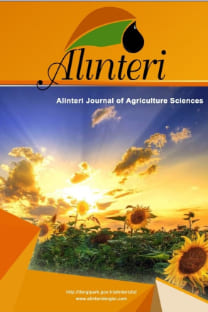Fungal İnokulasyon Yoluyla Lignoselülozik Yapının Parçalanabilirliği ve Buğday Samanında Yem Değerinin Artırılması I. Kuru Madde Parçalanabilirliği
Araştırmada Pleurotus eryngii ve Phanerochaete chrysosporium funguslarınınbuğday samanına üre ilaveli ve üre ilavesiz forumlarda inoküle edilerek hazırlanmışkarışımlarının rumen ortamındaki kuru madde parçalanabilirliği tespit edilmiştir. 4 baş 20 aylık yaşta Siyah Alaca erkek hayvan kullanılmıştır. PC+S, PC+S+%1ÜRE, PE+S,PE+S+%1ÜRE, S+%1ÜRE ve SAMAN (kontrol) biçiminde hazırlanan karışımlar 0, 4, 8, 16, 24, 48, 72 ve 96 saatlik inkübasyon sürelerinderumen ortamında tutulmuşlardır. Kuru madde parçalanabilirliği bakımından karışım grupları ve inkübasyon süreleri arasındaki farklılıkların önemli (P<0.01) olduğu tespit edilmiştir.
Anahtar Kelimeler:
Lignoselülozik, Pleurotus eryngii, Phanerochaete chrysosporium
Degradation of Lignocellulosic Structures by Fungal Inoculation and Determination of Feed Value Using In-situ Nylon Bag Technique of Wheat Straw: I. Dry Matter Degradability
This study was carried out to determine the effect of inoculation of Phanerochaete chrysosporium (PC) and Pleurotus eryngii (PE) fungis in wheat straw (S) with treated and untreated urea on in-situ dry matter degradability in rumen. The four rumen cannulated Holstein bulls, average 400 kg live weight, were used as animal material. Wheat straw (control) and other feed combination groups such as PCS, PCSU, PES, PESU, SU were incubated for 0, 4, 8, 16, 24, 48, 72 and 96 hours for in-situ dry matter degradability and digestibility in the rumen. It was found that differences in terms of dry matter degradibilities among the feed mixture groups were found to be significant (P<0,01).
___
- Alçiçek, A., Kılıç, A., Ayhan, V., Özdoğan, M., (2010). Türkiyede Kaba Yem Üretimi Ve Sorunları. TMMOB Ziraat Mühendisleri Odası, VII. Teknik Kongresi Bildiriler Kitabı -1, 11-15 Ocak 2010 Milli Kütüphane Kongre Salonu ANKARA
- AOAC. 1998. Official methods of analysis. Association of Official Analytical Chemists, Arlington, VA.
- Duncan, D.B, 1955. Multiple range and multiple F test, Biometrics, 11:1-42.
- Forsberg, C.W., Cheng, K.J. and White, B.A. (1997). Polysaccharide Degradation In The Rumen And Large Intestine. In: Gastrointestinal Microbiology (Mackie, R.I. and White, B.A., Eds.), pp. 319–379. Chapman and Hall, New York
- Fox, D.G., Barry, M.C., Pitt, R.E., Roseler, D.K. and Stone, W.C. (1995) Application of the Cornell net carbohydrate and protein model for cattle consuming forages. J. Anim. Sci. 73, 267-277
- Hungate, R.E. (1966). The Rumen and Its Microbes. Academic Press, New York.
- Krause, D.O.,. Denman, S.E., Mackie, R.I., Morrison, M., Rae, A. L., Attwood, G.T. McSweeney, C.S., (2003). Opportunities To Improve Fiber Degradation In The Rumen: Microbiology, Ecology, And Genomics, FEMS Microbiology Reviews 27, 663:693.
- McSweeney C.S., Dulieu A., Katayama Y., Lowry J.B. (1994) Solubilisation Of Lignin By The Ruminal Anaerobic Fungus Neocallimastix Patriciarum. Appl. Environ. Microbiol. 60, 2985–2989.
- SPSS, 2014. SPSS for Windows. Released 20.0 SPSS Inc., Chicago, Illinois, USA
- Wilkins, R.J. and Minson D.J., 1970. The Effects Of Grinding, Supplementation And Incubation Period On Cellulose Digestibility In Vitro And Its Relationship With Cellulose And Organic Matter Digestibility In Vivo. J. Agric. Sci. 74,445–451.
- ISSN: 2564-7814
- Başlangıç: 2007
- Yayıncı: Adem Yavuz SÖNMEZ
